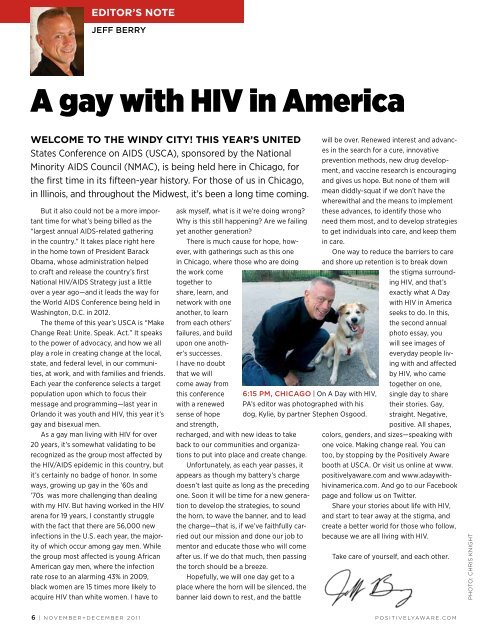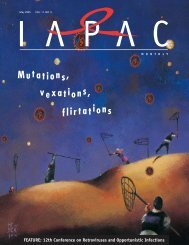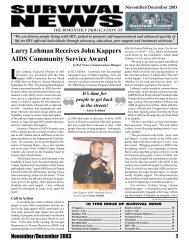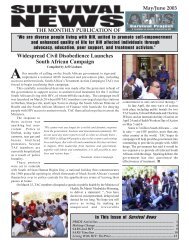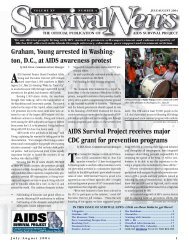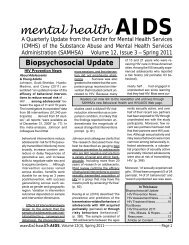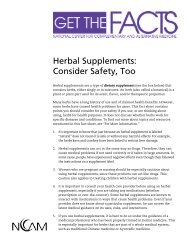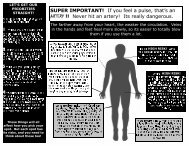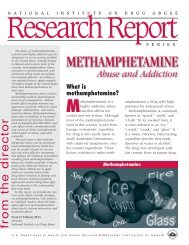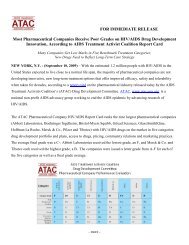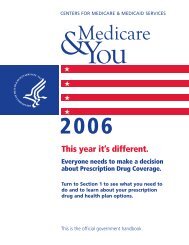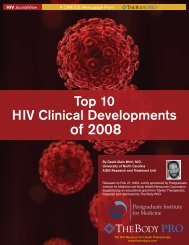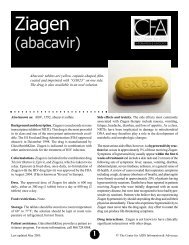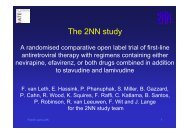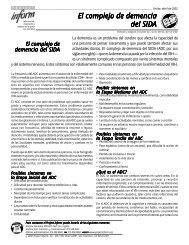Briefly - CD8 T cells - The Body
Briefly - CD8 T cells - The Body
Briefly - CD8 T cells - The Body
Create successful ePaper yourself
Turn your PDF publications into a flip-book with our unique Google optimized e-Paper software.
eDitoR’s note<br />
Jeff Berry<br />
A gay with HIV in America<br />
welcome to the winDy city! this yeaR’s uniteD<br />
States Conference on AIDS (USCA), sponsored by the National<br />
Minority AIDS Council (NMAC), is being held here in Chicago, for<br />
the first time in its fifteen-year history. For those of us in Chicago,<br />
in Illinois, and throughout the Midwest, it’s been a long time coming.<br />
But it also could not be a more important<br />
time for what’s being billed as the<br />
“largest annual AIDS-related gathering<br />
in the country.” It takes place right here<br />
in the home town of President Barack<br />
Obama, whose administration helped<br />
to craft and release the country’s first<br />
National HIV/AIDS Strategy just a little<br />
over a year ago—and it leads the way for<br />
the World AIDS Conference being held in<br />
Washington, D.C. in 2012.<br />
<strong>The</strong> theme of this year’s USCA is “Make<br />
Change Real: Unite. Speak. Act.” It speaks<br />
to the power of advocacy, and how we all<br />
play a role in creating change at the local,<br />
state, and federal level, in our communities,<br />
at work, and with families and friends.<br />
Each year the conference selects a target<br />
population upon which to focus their<br />
message and programming—last year in<br />
Orlando it was youth and HIV, this year it’s<br />
gay and bisexual men.<br />
As a gay man living with HIV for over<br />
20 years, it’s somewhat validating to be<br />
recognized as the group most affected by<br />
the HIV/AIDS epidemic in this country, but<br />
it’s certainly no badge of honor. In some<br />
ways, growing up gay in the ’60s and<br />
’70s was more challenging than dealing<br />
with my HIV. But having worked in the HIV<br />
arena for 19 years, I constantly struggle<br />
with the fact that there are 56,000 new<br />
infections in the U.S. each year, the majority<br />
of which occur among gay men. While<br />
the group most affected is young African<br />
American gay men, where the infection<br />
rate rose to an alarming 43% in 2009,<br />
black women are 15 times more likely to<br />
acquire HIV than white women. I have to<br />
ask myself, what is it we’re doing wrong?<br />
Why is this still happening? Are we failing<br />
yet another generation?<br />
<strong>The</strong>re is much cause for hope, however,<br />
with gatherings such as this one<br />
in Chicago, where those who are doing<br />
the work come<br />
together to<br />
share, learn, and<br />
network with one<br />
another, to learn<br />
from each others’<br />
failures, and build<br />
upon one another’s<br />
successes.<br />
I have no doubt<br />
that we will<br />
come away from<br />
this conference<br />
with a renewed<br />
sense of hope<br />
and strength,<br />
recharged, and with new ideas to take<br />
back to our communities and organizations<br />
to put into place and create change.<br />
Unfortunately, as each year passes, it<br />
appears as though my battery’s charge<br />
doesn’t last quite as long as the preceding<br />
one. Soon it will be time for a new generation<br />
to develop the strategies, to sound<br />
the horn, to wave the banner, and to lead<br />
the charge—that is, if we’ve faithfully carried<br />
out our mission and done our job to<br />
mentor and educate those who will come<br />
after us. If we do that much, then passing<br />
the torch should be a breeze.<br />
Hopefully, we will one day get to a<br />
place where the horn will be silenced, the<br />
banner laid down to rest, and the battle<br />
6:15 Pm, ChICago | On A Day with HIV,<br />
PA’s editor was photographed with his<br />
dog, Kylie, by partner Stephen Osgood.<br />
will be over. Renewed interest and advances<br />
in the search for a cure, innovative<br />
prevention methods, new drug development,<br />
and vaccine research is encouraging<br />
and gives us hope. But none of them will<br />
mean diddly-squat if we don’t have the<br />
wherewithal and the means to implement<br />
these advances, to identify those who<br />
need them most, and to develop strategies<br />
to get individuals into care, and keep them<br />
in care.<br />
One way to reduce the barriers to care<br />
and shore up retention is to break down<br />
the stigma surrounding<br />
HIV, and that’s<br />
exactly what A Day<br />
with HIV in America<br />
seeks to do. In this,<br />
the second annual<br />
photo essay, you<br />
will see images of<br />
everyday people living<br />
with and affected<br />
by HIV, who came<br />
together on one,<br />
single day to share<br />
their stories. Gay,<br />
straight. Negative,<br />
positive. All shapes,<br />
colors, genders, and sizes—speaking with<br />
one voice. Making change real. You can<br />
too, by stopping by the Positively Aware<br />
booth at USCA. Or visit us online at www.<br />
positivelyaware.com and www.adaywithhivinamerica.com.<br />
And go to our Facebook<br />
page and follow us on Twitter.<br />
Share your stories about life with HIV,<br />
and start to tear away at the stigma, and<br />
create a better world for those who follow,<br />
because we are all living with HIV.<br />
Take care of yourself, and each other.<br />
6 | N O V E M B E R + D E C E M B E R 2 0 1 1 P O s i t i V E lyAwA R E . C O M<br />
PhOtO: ChRis KNight


